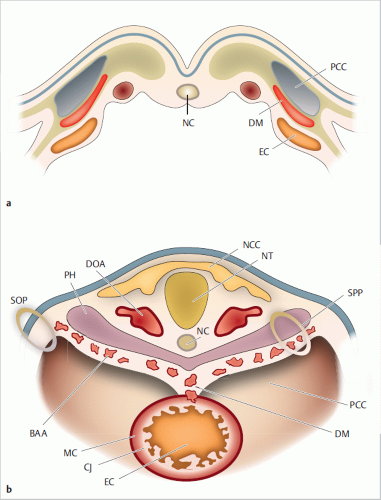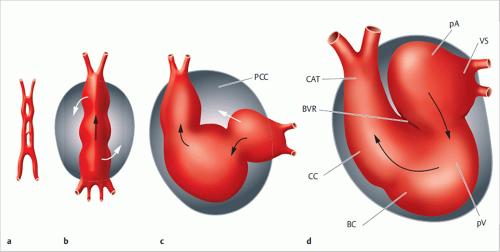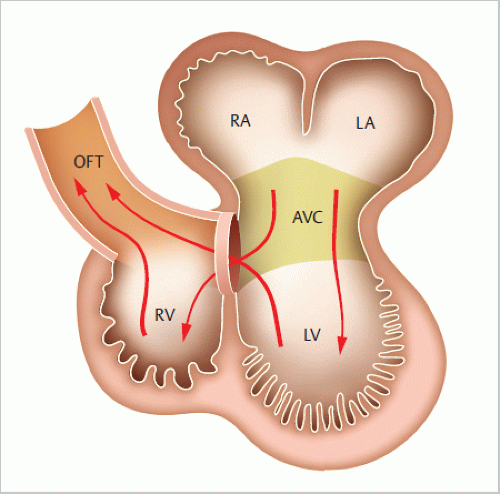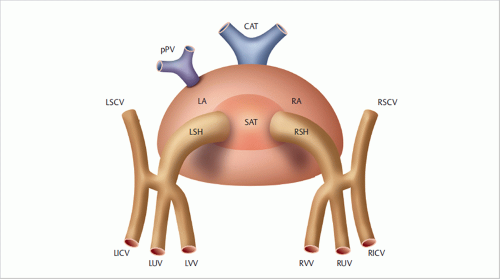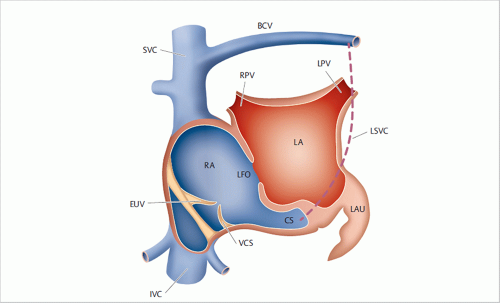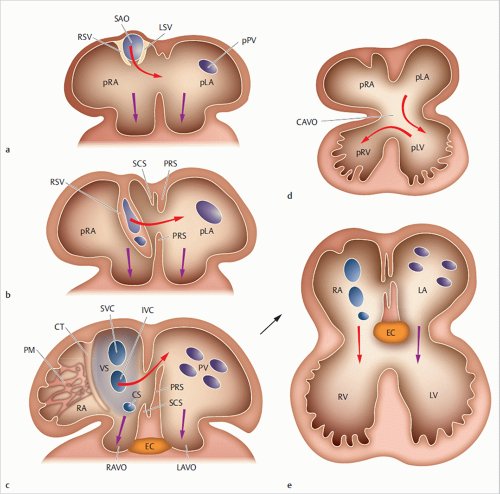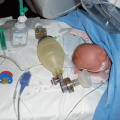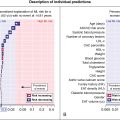A firm basis of knowledge regarding the regular morphogenesis of the heart and cardiac-adjacent vascular system (normogenesis) and of chronological sequence (▶
Table 1.1) makes it easier to obtain a basic understanding of complex congenital heart defects. The determination periods for pathogenesis are important with regard to the formal genesis of congenital defects (▶
Table 1.2). A multitude of different pathogenetic mechanisms can cause identical malformations during these periods.
1.1.1 Precordial Phase (Weeks 1 and 2 of Development Post Ovulation)
During the precordial phase (▶
Fig. 1.1a), a primitive circulatory system is formed to ensure that the embryo is supplied with nutrients. Once it reaches a thickness of 0.1 mm, the embryo can no longer be supplied with nutrients via diffusion alone. The embryonic blood islands fuse gradually into a primitive reticular capillary system. At the start of week 3 of development, the angioblasts migrating from the yolk sac group together and then form simple endothelial tubes. These tubes transform subsequently into organ-type, final vessel patterns under the influence of humoral and hemodynamic factors via proliferation, differentiation, and regression.
1.1.2 Cardiac Phase (Weeks 3-8 of Development Post Ovulation)
True cardiogenesis begins in the embryo, now approximately 1.5 mm long, with the formation of the horseshoe-shaped cardiogenic plate (▶
Table 1.1). During the blastoderm’s development and the massive growth of the dorsal neural tube, the cardiogenic zone is displaced caudal-ventrally. Afterward, the ventral thoracic wall closes over the pericardial cavity above the ectoderm. A single, three-layer cardiac tube forms from the fusion of the extraembryonic and intraembryonic vessel plexus (▶
Fig. 1.1b). This structure, now approximately 1 mm long, consists of an inner endocardial lining, an external myoepicardial layer, and an intermediate gelatinous matrix area (cardiac jelly). The initially elongated cardiac tube then connects dorsally to the serous-lined epicardial cavity via a wide mesocardium. Vascular poles for the cranial artery and caudal vein are already distinguishable during this stage. The venous vascular poles situated in the transverse septum provide drainage for both the extraembryonic and intraembryonic venous branches. The cardiogenic plate formed on day 22 p.o., now actively contracting, pumps the blood along the cranial arterial vascular pole into the paired dorsal aortae. These aortic arteries are likewise connected to the placenta via the umbilical arteries.
This transformation of the elongated cardiac tube into an arched cardiac tube occurs on approximately day 21 (▶
Fig. 1.2). In contrast to previous morphogenesis occurring exclusively in symmetry, asymmetric lateralization takes place for the first time in the form of cardiac looping, which lasts only about 24 hours. This usually occurs autonomously and independently of hemodynamic factors. Once the cardiac tube has been relatively fixed at the vascular poles, the stretched “systemic arterial” portion of the cardiac tube deviates ventral-caudally and then toward the right. The inferior “systemic venous” inflow portion of the cardiac tube deviates dorsally and then to the left during the course of this primary dextrorotation (d-loop) of the central section with rightward convexity. As of day 23 p.o., already defined sections of the cardiac tube and the sulci dividing them can be distinguished (▶
Fig. 1.2), namely, the venous sinus, atrium commune or primitive atrium, primitive ventricle, bulbus cordis, conus cordis, and truncus arteriosus.
Significant bulging of the individual cardiac tube segments, which demarcates additional external furrows and folds, occurs between days 26 and 30. They will later be of importance during septation, the development of the valve system, and differentiation of the conduction system. The technical conditions that allow final separation of the pulmonary and systemic circulation vascular beds by means of complex internal septation of a primary singular, tubular lumens are achieved during the cardiac plate’s displacement from the neck region to the superior thoracic area (descensus cordis), as necessitated by growth.
Since the cavum is not yet smooth in structure at the start of tube formation (cardiac looping), initial trabeculation then develops adjacent to the interventricular foramen (▶
Fig. 1.3). Subsequently, the primitive ventricle that will later form the majority of the morphologic left ventricle is completely trabeculated. The morphologic right ventricle develops from the proximal, curved section of the bulbus cordis. The joint outflow tract for both ventricles is formed from the distal, elongated section of the bulbus. The truncus arteriosus is formed from the roots of the major arteries.
Cardiogenesis is not fully completed until after birth, upon the functional closure of the foramen ovale and obliteration of the ductus arteriosus.
Morphogenesis of the Atrial Region
The final atrium gains its structure via four complex mechanisms:
Incorporation of the venous sinus,
Formation of the systemic vein junction region,
Development of the atrial sinus valves and the valve apparatus of the foramen ovale, and
Atrial compartmentalization via development of the interatrial septa.
The smooth-walled venous sinus is integrated into the final atrial segment during days 28-30 p.o. In addition to a main section draining into the atrial segment, a left and right sinus horn—each incorporating the paired cardinal, umbilical, and vitelline veins—can be differentiated on the venous sinus (▶
Fig. 1.4). Once the primary portal circulatory systemhas developed, the lower hollow veins directly adjacent to the heart first develop from the right hepatic vein, and the upper hollow veins from the right sinus horn. The atrial segment is separated from the venous sinus on day 26 p.o., with the development of a crescent-shaped, left-facing sinoatrial septum. This causes functional separation of the presumptive left atrium from the right atrium, whose broad connection to the venous sinus remains in place. Hence, all cardiopetal veins are connected exclusively to the final right atrium. Within the scope of progressive atrialization of the central venous sinus section, venous valves (▶
Fig. 1.5 and ▶
Fig. 1.6) and the venous sinus septum—from which the valve of the inferior vena cava (Eustachian valve) and the coronary sinus valve (Thebesian valve) are later derived—are distinguishable (▶
Fig. 1.5). While the smooth-walled, dorsally situated areas are formed by integrating the primary veins of the venous sinus on the left and the primary pulmonary veins on the right, the muscular trabeculated auricles are remnants of the primitive atrium.
Morphogenesis of the Pulmonary Veins
The pulmonary buds are initially supplied with blood via the visceral vessels. Pulmonary venous drainage into the left and right superior cardinal veins occurs via the pulmonary plexus and the splanchnic veins. Only after the primitive (or primary) pulmonary vein stem has sprouted from the posterior wall of the left atrium (day 28-30 p.o.; ▶
Fig. 1.6) do the first anastomoses appear between the pulmonary and peribronchial capillary plexus and the twice-divided pulmonary venous stem. First the primary pulmonary vein stem, then the four distinct pulmonary veins formed by its two divisions are incorporated into the posterior wall of the left atrium by means of relative growth movements. Thus, the smooth, thin posterior wall of the morphologic left atrium develops from the primary pulmonary veins, though not the retroposed trabeculated portion of the atrium.
Compartmentation of the Atrial Region
During invagination of the atrial wall, two valve-like structures—the sinoatrial valves—that fuse cranially to
the septum spurium and later regresses, are demarcated on the sinoatrial transition. True septation becomes externally visible upon development of a constriction—the atrioventricular sulcus, which is located along the bend between the bulbus cordis and truncus arteriosus. Nearly simultaneously, the interatrial sulcus forms on the posterior-cranial circumference of the primitive atrium, corresponding luminally to the septum primum, which is also semicircular. The free, concave lower margin of the septum primum that primarily provides vertical separation between the common atrium comprises the upper margin of the foramen, or ostium primum. As of approximately day 35 p.o., there is visible evidence of multiple, successively confluent perforations from which the foramen or ostium secundum emerges.
The fusion of portions of the lower margin of the septum primum with the endocardial cushion located on the plane of the later atrioventricular valves causes the ostium primum to decrease in size before finally disappearing between days 37 and 42 p.o. In the meantime, the ostium secundum ensures the hemodynamically crucial horizontal connection of the atria, which is subsequently modified by the development of the septum secundum located further to the right. The septum secundum also emerges between the septum primum and the venous sinus valve as a development of the anterior cranial atrial roof and grows in the direction of the base of the heart or endocardial cushion. The foramen ovale, whose functional closure and subsequent postnatal obliteration marks the end of final separation of the atria, forms by connecting the free margins of the septum primum to those of the septum secundum. The foramen ovale valve extending from the septum primum is first pressed into the limbus extending from the septum secundum as a result of postnatal pressure increases in the left atrium (▶
Fig. 1.7) thereby completing the fossa ovalis.
Development of the Heart-Adjacent and Body Venous System
The venous system is much more variable than the arterial system due to the development of a heterogeneous capillary network from which the final vascular beds form initially based on regional preference.
The sinus horns, bilaterally symmetrical from this point onward, can then be perceived as the proximal portion of the non-fused early embryonic endocardial tubes that feed into the venous sinus (▶
Fig. 1.8a).
Fundamentally, a distinction can be made on both sides between three main venous systems:
Umbilical veins,
Vitelline veins, and
Cardinal veins.
All three systems drain their blood via the ipsilateral sinus horn into the common venous sinus functioning as a sinoatrial transition (▶
Fig. 1.4). In doing so, the umbilical veins transport the oxygen- and nutrient-rich chorionic villi and placental villi blood from the umbilical cord, while the vitelline veins transport the blood from the vitelline, visceral, and portal venous systems and the supracardinal and infracardinal veins transport blood from the embryo’s superior and inferior body segments. The umbilical veins quickly connect to the capillary plexus and sinusoids of the disproportionately fast-developing liver, so that their blood henceforth flows directly to the venous sinus via intrahepatic anastomoses. After involution of the extrahepatic portion of the umbilical veins, their blood can only reach the venous portal of the heart transhepatically, along with the vitelline venous blood. After involution of the left sinus horn, this blood reaches the venous portal posthepatically, via the right vitelline vein. Conversely, a shunt system essential to embryonic fetal circulation develops, namely the venous sinus that transports oxygen-rich umbilical venous blood directly to the heart by circumventing the hepatic vascular bed. Finally, the right umbilical vein completely regresses so that placental blood can reach the left umbilical vein only via the liver (▶
Fig. 1.8b). The left umbilical vein and the venous duct are obliterated postnatally to become the venous ligament of the liver.
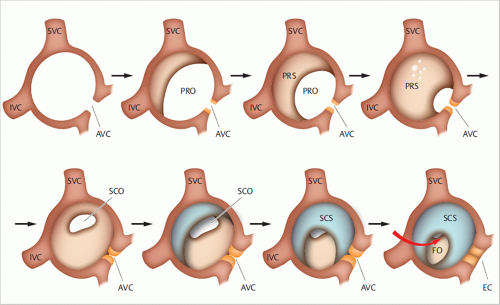


 Get Clinical Tree app for offline access
Get Clinical Tree app for offline access

